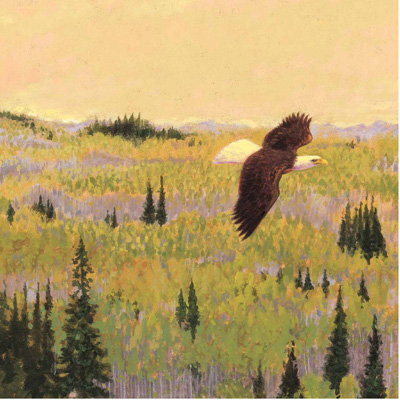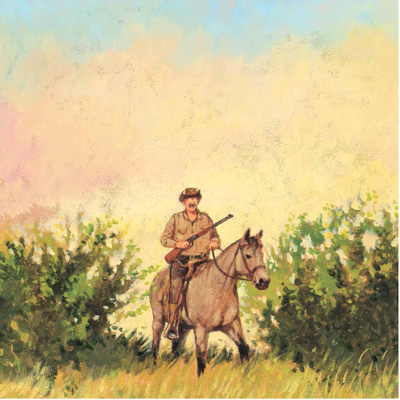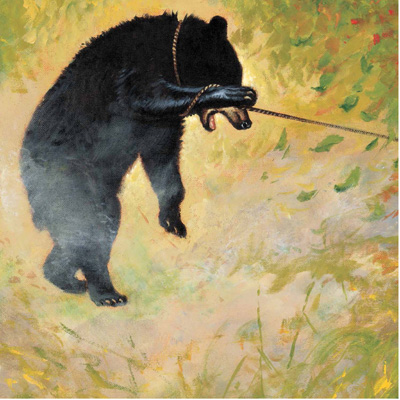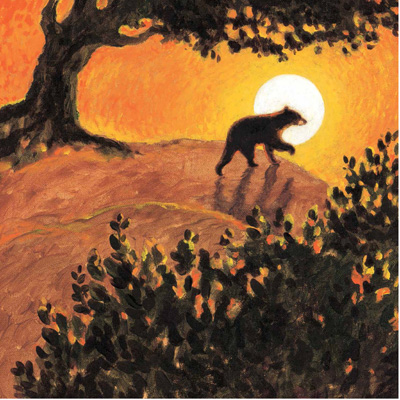
In memory of my mother.
Gijsbert van Frankenhuyzen
For my best friend and partner in life and writing, Debbie.
And to the everlasting memory of my mom, Kathleen Murphy.
Frank Murphy
Text Copyright 2000 Frank Murphy
Illustrations Copyright 2000 Gijsbert van Frankenhuyzen
Clifford Berryman cartoon courtesy of Theodore Roosevelt Collection, Harvard College Library
All rights reserved. No part of this book may be reproduced in any manner
without the express written consent of the publisher, except in the case of brief
excerpts in critical reviews and articles. All inquiries should be addressed to:
Sleeping Bear Press
310 North Main Street, Suite 300
Chelsea, MI 48118
www.sleepingbearpress.com
2001 Sleeping Bear Press is an imprint of Gale.
Printed and bound in China.
10 9 8 7
Library of Congress Cataloging-in-Publication Data.
Murphy, Frank, 1966
The legend of the teddy bear / by Frank Murphy ; illustrations by Gijsbert van Frankenhuyzen.
p. cm.
ISBN: 978-1-58536-013-0
1. Roosevelt, Theodore, 1858-1919Juvenile literature. 2. Roosevelt, Theodore, 1858-1919
JourneysMississippiJuvenile literature. 3. Teddy bearsHistoryJuvenile literature. 4. Bear
huntingMississippiHistory20th centuryJuvenile literature. [1. Teddy bearsHistory. 2.
Roosevelt, Theodore, 1858-1919.]
I. Frankenhuzyen, Gijsbert van, ill. II. Title.
E757 .M945 2000
973.911092dc21 00-009986

The Legend of the Teddy Bear
By Frank Murphy
Illustrated by Gijsbert van Frankenhuyzen

In the days when America was a younger country and much of the land was filled with dense green forests, animals roamed freely through the great American wilderness.

In the cities, the clip-clop of horses feet could be heard as they pulled black buggies through bustling streets. Smoking black trains rolled across the countryside connecting cities and towns to prairies and forests, moving travelers across the wild territories of America.

In those days there lived a strong, adventurous man with a big, bushy mustache. He was the President of the United States of America, and his name was Theodore Roosevelt. The people of America adored their President and they fondly called him Teddy.

Teddy Roosevelt loved adventures. He loved to go exploring while riding on his horse, Manitou. Teddy wandered through the wooded valleys of Pennsylvania and climbed the towering peaks of the Colorado Rockies. He roamed the sweeping green prairies, marveling at natures beauty. But one of the things Teddy loved to do the most was camp in the wide-open spaces of America and fall asleep under a blanket of a thousand twinkling stars.


Teddy often rode on Manitou while hunting wild animals. In those days, many Americans hunted deer and bears. Teddy loved hunting too. During one trip, Teddy traveled to the states of Mississippi and Louisiana. The two states wanted this great and fair man to settle an argument about a boundary line. When his work was done, he decided to explore the green forests of Mississippi and go bear hunting.

Late in the day, on November 14, 1902, as the sun was setting, some of the men in the presidents group cornered a young bear. Barking dogs surrounded the frightened bear, as the men roped and tied it to a tree.
One of the men cried out, President Roosevelt! Come quick! We have a bear for you!

Branches cracked and twigs snapped as President Roosevelt raced Manitou through the thick forest. Hearing the excited voices of his men, he reached the clearing where the men and barking dogs were gathered. All were pointing at a bear that had been roped and tied to a tree. The frightened bear clawed at the rope, trying to free itself. The bear whipped his head back and forth. Its back feet kicked up clouds of dust and dirt.


Teddy looked down at his rifle and then... laid it on the ground. He shouted out to his men, Stop badgering that bear! It is helpless. Let it go! Following the presidents orders the men cut the rope and let the bear go free.




A few days later a newspaper cartoonist named Clifford Berryman heard about the presidents meeting with the bear. He drew a cartoon illustrating President Roosevelt and a wild bear. The cartoon first appeared in a newspaper called The Washington Post. People everywhere were talking about how the president had ordered his men to let a wild bear go free. Soon, the cartoon appeared in newspapers all over the country. People from New York to Michigan to California saw the cartoon and read about Teddys kindness toward the defenseless bear. The nations love for their president grew even stronger.
A couple from New York, Rose and Morris Michtom, saw the cartoon while reading their morning newspaper and, like so many other people of America, were touched by what President Roosevelt had done.
Rose and Morris owned a candy shop. They loved having children visit their shop. Big glass jars, stuffed full of brightly colored candy, lined the shelves. The smell of peppermint and lemon drops and licorice sticks filled the air. There were shelves with porcelain dolls, shelves with wooden toy soldiers, and shelves with windup toy trains.
Next page



























